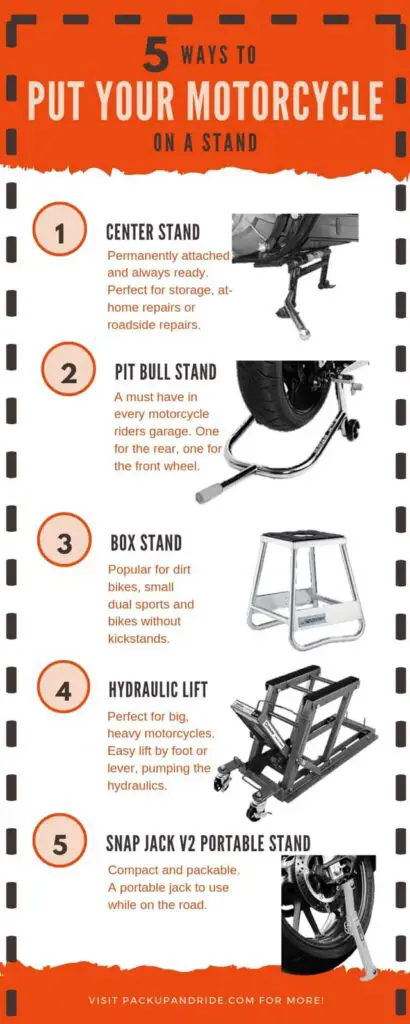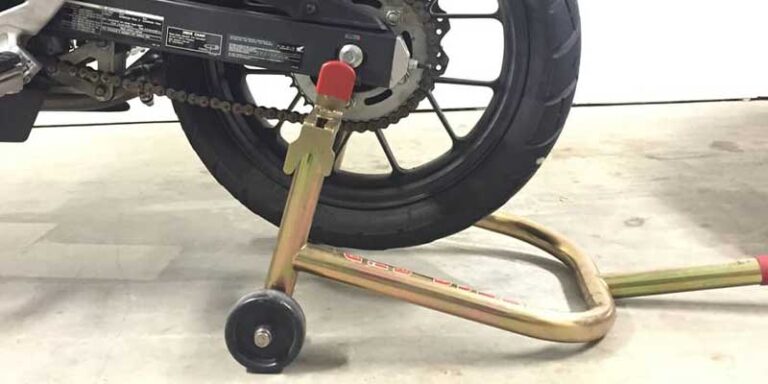If you’re like me, you enjoy doing your own maintenance work on your motorcycle at home. And no motorcycle garage would be complete without some type of stand for your bike. A stand makes it possible to do so many repair jobs from things as simple as lubing your chain, to removing the wheels or doing a complete front fork rebuild.
There are a lot of different types of motorcycle stand for different motorcycle models. It’s important to understand what each one does so that you can choose the best motorcycle stand. Sometimes you’ll find yourself needing to put your bike on a stand when you’re on a ride in the case of a breakdown. So, this article will cover 9 different methods for putting your motorcycle up on a stand.
Center Stand
Center stands are permanently installed on the motorcycle usually in addition to a kickstand or side stand. Center stands are probably most common on dual sports, adventure bikes and touring bikes, although just about any standard or sport bike can have one installed. Big, heavy cruisers don’t generally have center stands due to their weight.
The center motorcycle stand is installed just under the center portion of the bike and attached to the frame. It is spring loaded to keep it folded up under the bike when not in use. When the motorcycle is on the stand, the rear wheel will be lifted off the ground by a couple of inches. This makes it very easy to do any type of maintenance on the rear wheel and chain, or if you just need the bike upright to do maintenance. The front wheel, however, will still contact the ground.
Use caution when placing your motorcycle on the center stand as it will not be as stable as it is on the side stand. Center motorcycle stands provide only a narrow footprint and raise the center of gravity leaving your bike more vulnerable to tipping over. Center stands aren’t’ really designed to be used every time you park your motorcycle but they can be really handy when parking on some surfaces such as on a slight sideways incline. The center stand is also very nice to have if you do a lot of touring. It make chain maintenance on the road very easy and, if you have to fix a flat on the road, a center stand will make that possible. Another benefit is that it makes it easier to pack side cases when the bike is up on the stand. I find it a lot easier to secure bags onto my motorcycle if it is upright rather than leaning to one side.
Putting your motorcycle on the center stand can be tricky especially if you have a heavy bike or if you don’t have the upper body strength to do it. But, there is a technique to it. Stand at the left side of your bike. With your right foot, hold the center stand against the ground. With your right hand, grab the left side of the motorcycle (some bikes come with a special handle for this) and lift up, while at the same time, kicking your right foot and the center stand forward. The motorcycle will pop up onto the stand. It takes some practice to get it right, but once you figure out the leverage points, it will become second nature. To take your bike off the center stand, simply push the bike forward slightly and the stand will snap back up, and your bike will plop back to the ground. Be sure to hold it steady and have the kickstand ready to hold the bike up.
Dirt Bike Box Stand
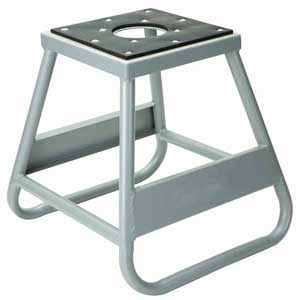
This is the simplest stand you can own. It’s basically a small square platform on a box shaped frame that’s about a foot or two tall. You will most often see these types of stands around the dirt bike track as generally dirt bikes do not come with kick stands. To get your motorcycle onto this stand you will have to lift it up and set it on the stand yourself.
Dirt bikes are not very heavy compared to other motorcycles and there is a simple technique to lifting the bike onto the stand without injuring yourself or pulling your back out. To lift it up:
- Stand on one side of the bike
- Grab the rear fender on the opposite side
- Squat down slightly and push your hip against the motorcycle
- Lift up with your hip and legs and swing the bike onto the stand
Your legs and hips are doing the heavy lifting rather than your arms and back. When you do it right, it’s a simple 2 second process. Places you should NOT grab and lift are the pipes, the rear wheel or reaching down to pick it up by the swing arm. Doing so could cause injury (hot pipes) or cause you to do a whole lot more work that you need to.
Rear Swing Arm Stand
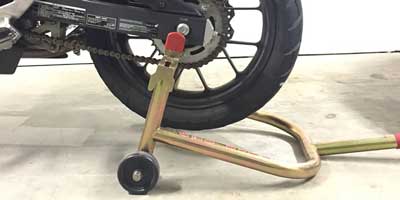
Rear wheel stands with swing arm attachments are a very common way to lift up the rear wheel of your motorcycle. These stands are designed to lift the motorcycle by fitting under the swing arms. The shape of the lift, along with its wheels, uses leverage to lift the bike up a few inches off the ground. There are several different brands on the market and most will come with different attachments to accommodate different bikes. I personally use a Pit Bull stand and I’ve been very happy with it. You can find them on Amazon. Padded platforms are designed to lift the bike from under the swings arms. Spool attachments allow you to lift the bike from rear wheel spools. I’ve always found it easier to use rear swing arm spools with the stand and the spools also double as rear sliders adding protection if your bike goes down.
Most rear stands are universal and will work with nearly all motorcycles. However, if you have a motorcycle with a single sided swing arm, you’ll need a stand designed for it. These stands work the same way, but they will attach to the side without the swing arm by fitting into the wheel axle.
Like any stand, it takes a little bit of practice to hold your motorcycle in place with one hand and line up the stand with the other. It’s a bit of a balancing act, but once you have it figured out, you’ll have no problems popping your bike up. A rear stand is hardly used by motorcycle riders. Nevertheless, many riders prefer rear stand for their motorcycles for extra safety on flat spots. It takes little effort to add a rear stand with a removable handle to your motorcycles.
Front Fork Stand
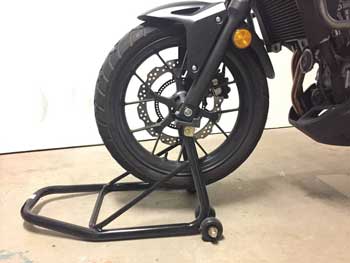
Front fork stands are similar to rear swing arm stands and you can often buy them in sets. Check out the price on a set here on Amazon. These stands are designed to kind of cradle the front forks between two supports, lifting the front wheel off the ground. The placement of the stand is super important because, if the forks don’t set in place just right, the motorcycle has a risk of falling off the stand. That would suck if you’ve taken off your front wheel already. Yikes.
Keep in mind that you can not use the front stand alone. It is not stable enough to hold your bike steady, so you must use it with a rear stand. Always put the bike on the rear stand first. This will provided the stability needed to enable you to raise the front wheel. Front for stands are great for storing your bike during the off season, for removing the front wheel or working on the brakes. However, you will not be able to remove the front forks with this kind of stand.
Triple Tree Stand
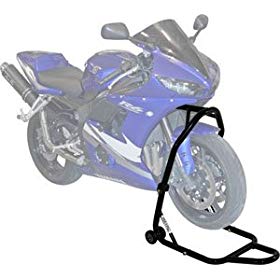
A Triple tree stand is very similar to a front fork stand, but instead of lifting the motorcycle by the forks, it attaches to the center hole under the triple tree. In case you don’t know, a triple tree, or triple clamp, is a somewhat triangular shaped clamp that attaches to the top of your forks and to the front of the motorcycle frame. Your handlebars are also attached to the triple tree.
Stands like this will come equipped with 4 or 5 different size pins to insure you have one that will fit your brand of motorcycle. These stands provide you with a stable platform allowing you to do a number of repairs to the front of the motorcycle, such as a front fork rebuild. Find one that fits your bike here.
Snap Jack Folding Portable Jack
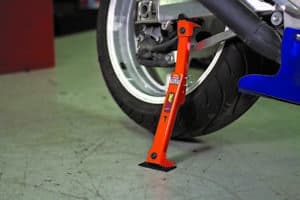
Not every motorcycle owner has room to store large motorcycle stands, or they want something that is portable that can be packed in their on board tool kit. That’s where the Snap Jack comes in handy. The Snap Jack, make by Tirox, is a patented two piece, folding stand that fits under the swing arm opposite side of the side stand or kick stand. When you push on it, it snaps into place, lifting the rear wheel off the ground by about an inch, or just enough to spin the wheel making it the perfect stand for doing chain and rear wheel maintenance on the road.
The first version of the Snap Jack had a few flaws, but thanks to consumers who voiced their concerns and wishes, the company came out with the Snap Jack V2 and included a lot of improvements. When you purchase it, the kit will come with a Velcro strap that you attach to the front brake lever to prevent the motorcycle from rolling forward. It also comes with two rubber non-skid pads that will assist in keeping the jack steady on a smooth surface. Cotter pins lock the jack into place when the bike is lifted, to prevent the jack from folding accidentally.
Installing the jack is a little tricky and make take several tries to get it at the right angle so it lifts the bike sufficiently. There are a few precautions to take when using the stand. When pushing the jack in place, as it snaps and lifts the bike, be sure to keep the fleshy part of your hand away from the hinge or it will take a bite out of you. Also, when releasing the jack, keep your fingers clear of the hinge. If you’re paying attention, you won’t have any problems with it, however, wearing a glove will help protect your skin from painful pinches.
Hydraulic Lift
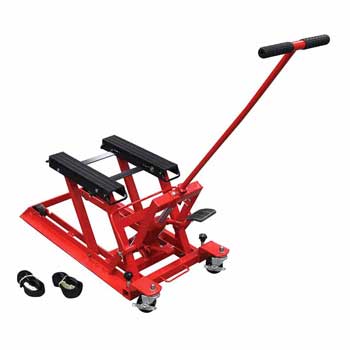
So far the stands I’ve talked about work great for sport bikes, smaller motorcycles or adventure bikes, but what if you have big 1300 pounder like a Gold Wing or a fully loaded Road King? This is where a hydraulic lift comes in handy. These lifts come in a variety of styles and brands but they all generally work the same. They come with casters so you can easily roll the lift under the motorcycle. Once you find a secure spot for it to lift against the frame, you’ll use a foot pump to begin lifting the bike. Some lifts will come with a handle so you can pump up the lift by hand.
Hydraulic lifts will raise the entire motorcycle from the center lifting both wheels off the ground. Some taller scissor lifts can lift a motorcycle up a couple of feet allowing you to work on the motorcycle while standing comfortably. Easier on the back. Be careful of scissor stands however, as the bike will lose stability the higher it is raised, especially large motorcycles. In any case, when you select a hydraulic lift, make sure you purchase one that will handle your motorcycles weight capacity. Not all stands are built tough enough to lift your heavy bike. Here’s one on Amazon that is rated to hold up to 1500 pounds. A good investment if you plan to do your own maintenance.
Hydraulic lifts also come in large professional models where you can roll your motorcycle onto a platform, some with wheel chocks, then raise the bike up so you can work on it while comfortable standing. These are great for some repairs, however, if you’re doing anything that requires the wheels be lifted off the platform, you’ll have to use a different stand.
Motorcycle Dolly
A motorcycle dolly has a different purpose than other motorcycle stands. It’s not designed to lift the motorcycle wheels off the ground but, it will keep your bike steady and in place while doing maintenance and repairs. A low profile dolly is used to move a heavy motorcycle around on a solid surface in any direction. Let’s say you have a limited amount of space in your garage and you want to park your motorcycle in a tight spot. Often backing it in can be tricky and you risk bumping into things as well as scratching or denting your motorcycle.
With a motorcycle dolly you will roll your bike onto the dolly and secure it into place. The wheels on the dolly will allow you to push it into any tight spot, against a wall, or where ever you need to fit it in your garage or shop. Very simple, very handy. They are surprisingly inexpensive too and you can find them easily, like this one on Amazon.
Other reasons for using a dolly is if you own more than one motorcycle, or have a collection and you may want to easily move your bikes around, rearrange them, bring one out for riding, etc. Or, if you have a motorcycle that you don’t ride very often that you need to occasionally move out of the way.
DIY Stand
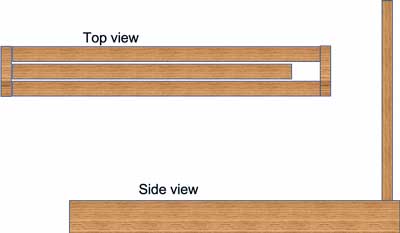
A lot of creative people have built their own motorcycle lifts and stands using woods, screws and nails. Sometimes you need something similar to a center stand or a hydraulic lift that lifts both wheels off the ground from the center of the motorcycle. A common DIY stand consists of several 2×4 or 2×6 pieces of lumber, glued and nailed together, this serves as the lift.
On one end of the lift, you can install a long piece of lumber, or long sturdy pipe to use as a handle. After sliding the homemade lift under the motorcycle, use the handle’s length for leverage, turning the lift onto its side. In doing so, it will lift the motorcycle off the ground.
A homemade box stand would be super easy to build using some two by fours and some sturdy plywood on the top and bottom. Apply some anti-skid rubber material under the legs to keep it from sliding when you lift the bike onto the stand. You can also apply rubber padding on the top to protect the bottom of your bike.
On the road I’ve seen dual sport riders getting very creative with stands on bikes that don’t have a center stand. Often a tree stump, a log, or a big rock will provide you with the perfect height to get your bike off the ground so you can repair a flat. Be extra cautions when doing something like this and make sure you don’t puncture a pip or oil pan by setting your bike on a jagged rock. Use common sense.
Remember, that any type of do it yourself, homemade lift or stand is not guaranteed to hold the weight of your motorcycle or is it guaranteed to keep your bike steady. While many people have had good luck with DIY stands, you still need to be cautious. The benefits of a manufactured stand over a homemade one, is that they are tested and rated to hold a certain amount of weight, and the company may provide some protection to the consumer if the stand or jack fails. However, if your DIY stand fails, your bike falls off and is damaged, that’s all on you. So, think it through before you build your stand.
To wrap it up, there you have 9 different ways you can lift up your motorcycle to make maintenance, repairs and storage much easier.
